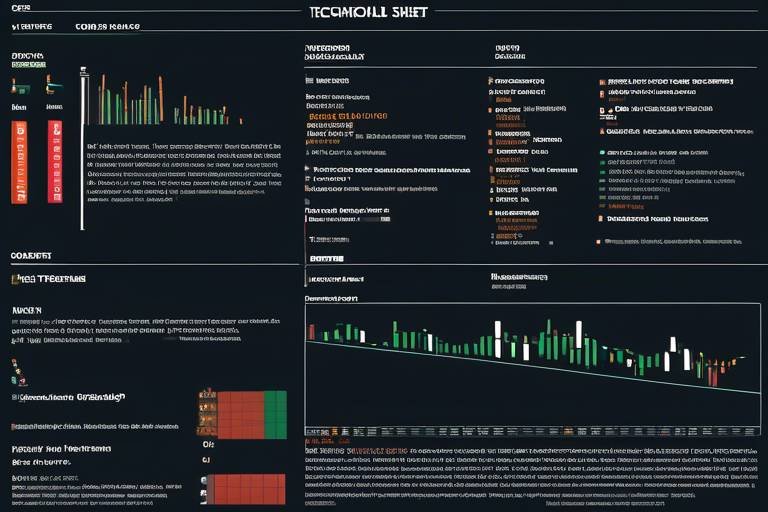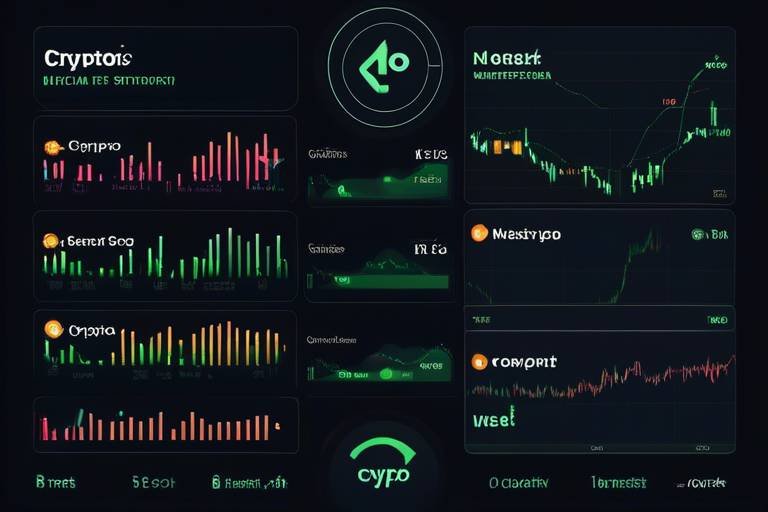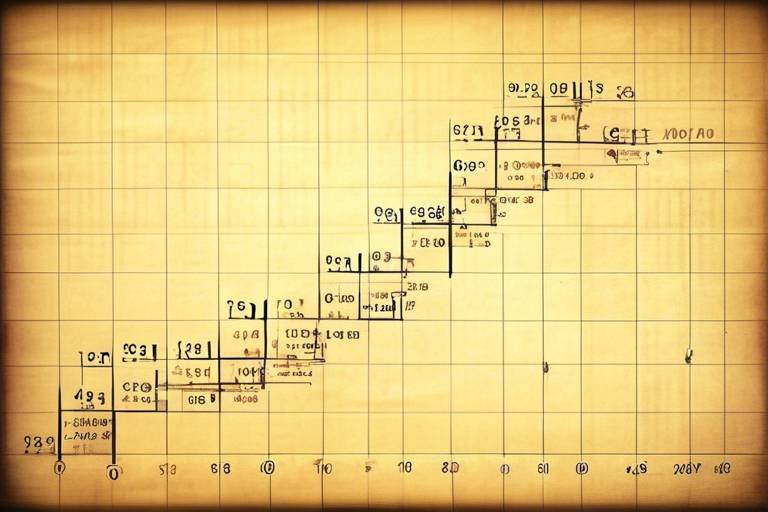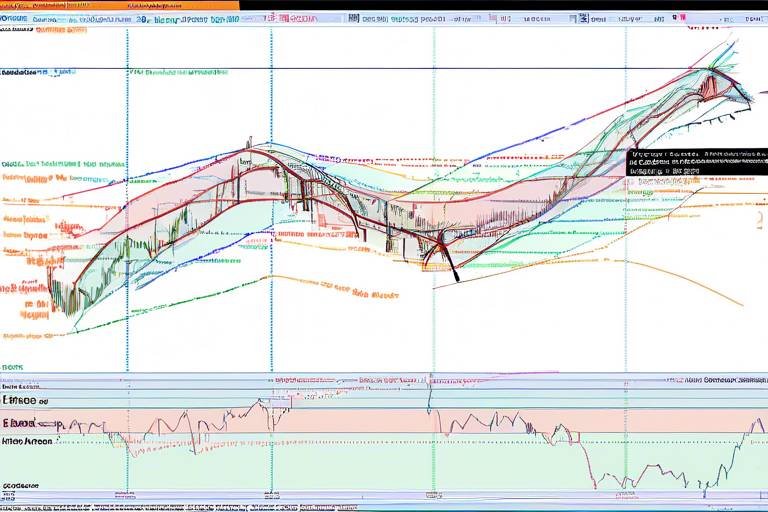The Role of Market Behavior in Technical Analysis
In the world of trading, understanding market behavior is like having a secret weapon. It’s more than just numbers on a screen; it’s about grasping the emotions, trends, and signals that drive the market. Technical analysis, which relies heavily on historical price patterns and volume data, becomes a powerful tool when combined with insights into how traders think and act. This article dives deep into how market behavior influences technical analysis, highlighting key concepts, trends, and indicators that traders utilize to make informed decisions in financial markets.
Imagine walking into a bustling marketplace. You can sense the excitement, the tension, and even the fear in the air. Similarly, in financial markets, market sentiment reflects the overall attitude of investors towards a particular security or market. This sentiment significantly impacts price movements and trends. When traders are optimistic, prices tend to rise; conversely, when fear sets in, prices can plummet. Understanding sentiment can enhance trading strategies and predictions, allowing traders to position themselves advantageously.
Now, let’s talk about technical indicators. These are mathematical calculations based on price and volume data that help traders identify trends, reversals, and potential entry or exit points in the market. Think of them as the compass guiding you through the foggy landscape of trading. Among the most popular indicators are moving averages, which smooth out price data to help traders identify the direction of the market over specific periods. They are essential tools for determining potential support or resistance levels.
Market sentiment is not just a buzzword; it's a crucial element in trading. It can be the difference between a profitable trade and a significant loss. When traders feel confident, they are more likely to buy, pushing prices up. On the other hand, fear can lead to a rush of selling, causing prices to drop. By keeping a finger on the pulse of market sentiment, traders can better anticipate price movements and adjust their strategies accordingly.
Among the many indicators available, moving averages stand out. They help traders smooth out price fluctuations and identify trends over time. The Simple Moving Average (SMA) calculates the average price over a specified period. This provides a clear view of the market trend, helping traders make decisions based on historical data. For instance, if the current price is above the SMA, it might indicate a bullish trend, while a price below could suggest a bearish outlook.
On the other hand, the Exponential Moving Average (EMA) gives more weight to recent prices, making it more responsive to new information. This characteristic allows traders to identify trends more quickly than with the SMA. Both types of moving averages can be used in conjunction to create a more comprehensive trading strategy.
Another critical aspect of technical analysis is volume analysis. This examines the number of shares traded during a specific period, providing insight into the strength of price movements. For instance, a price increase accompanied by high volume suggests strong buying interest, while a price increase with low volume may indicate a lack of conviction. Understanding volume can help traders confirm trends or identify potential reversals.
Chart patterns are visual representations of price movements that can signal future price behavior. Recognizing these patterns can help traders predict where the market might move next. One of the most well-known patterns is the Head and Shoulders, which signals a trend reversal. If you see this pattern forming, it might indicate that a bullish trend is about to turn bearish, making it crucial for traders looking to capitalize on market shifts.
Additionally, understanding support and resistance levels is vital. These are critical price points where the market tends to reverse or consolidate. Support levels are where buying interest is strong enough to overcome selling pressure, while resistance levels are where selling pressure can overcome buying interest. Recognizing these levels can help traders make strategic decisions regarding entry and exit points, maximizing their potential for profit.
Beyond numbers and charts, psychological factors play a significant role in market behavior. Traders' emotions, biases, and mental states can significantly influence their decision-making processes and affect market trends. The emotional rollercoaster of trading can lead to impulsive decisions that deviate from a well-thought-out strategy.
Two of the most powerful emotions in trading are fear and greed. When traders are overly optimistic, they may ignore warning signs and hold onto losing positions too long. Conversely, fear can lead to panic selling. Recognizing these emotions can help traders maintain discipline and stick to their trading strategies.
Another phenomenon to consider is herd behavior, where traders follow the crowd, often leading to market bubbles or crashes. Understanding this behavior can help traders anticipate market movements and make more rational decisions, rather than getting swept away by the tide of market sentiment.
- What is market sentiment? Market sentiment refers to the overall attitude of investors toward a particular security or market, influencing price movements.
- How do moving averages work? Moving averages smooth out price data to help identify trends over specific periods, aiding traders in decision-making.
- What is the significance of volume analysis? Volume analysis provides insights into the strength of price movements, helping traders confirm trends or identify potential reversals.
- What are support and resistance levels? These are critical price points where the market tends to reverse or consolidate, helping traders make strategic decisions.

The Importance of Market Sentiment
This article explores how market behavior influences technical analysis, highlighting key concepts, trends, and indicators that traders utilize to make informed decisions in financial markets.
Market sentiment is like the heartbeat of financial markets; it reflects the overall attitude of investors towards a particular security or market. This sentiment can significantly impact price movements and trends. Imagine walking into a room full of people whispering about a hot new stock—if the buzz is positive, it can create a wave of buying interest, pushing prices higher. Conversely, if the mood turns sour, fear can spread like wildfire, leading to sell-offs. Understanding this sentiment is crucial for traders looking to enhance their strategies and predictions.
At its core, market sentiment encompasses the collective feelings and emotions of investors. It can be influenced by a variety of factors, including economic news, earnings reports, and geopolitical events. For instance, a strong jobs report might boost investor confidence, while political instability could lead to uncertainty and fear. By keeping a finger on the pulse of market sentiment, traders can make more informed decisions about when to enter or exit trades.
To gauge sentiment, traders often rely on various indicators and tools. Some popular methods include:
- Surveys and Polls: Tools like the Investor Sentiment Survey can provide insights into how bullish or bearish investors feel.
- Social Media Trends: Monitoring platforms like Twitter and Reddit can reveal real-time sentiment shifts among retail investors.
- Market Indices: Analyzing indices like the VIX (Volatility Index) can help traders understand market fear levels.
Ultimately, recognizing and interpreting market sentiment can enhance trading strategies. For example, if traders notice a significant shift towards bullish sentiment, it may signal a good time to buy. On the other hand, a sudden spike in fear could be a warning sign to lock in profits or cut losses. By integrating sentiment analysis into their trading toolkit, investors can navigate the often tumultuous waters of the financial markets with greater confidence.
Technical indicators are mathematical calculations based on price and volume data. They help traders identify trends, reversals, and potential entry or exit points in the market.
Moving averages smooth out price data to identify trends over specific periods. They are essential tools for traders to determine market direction and potential support or resistance levels.
The Simple Moving Average calculates the average price over a specified period, providing a clear view of the market trend and helping traders make decisions based on historical data.
The Exponential Moving Average gives more weight to recent prices, making it more responsive to new information. This characteristic allows traders to identify trends more quickly than the SMA.
Volume analysis examines the number of shares traded during a specific period. It provides insight into the strength of price movements and helps traders confirm trends or reversals.
Chart patterns are formations created by the price movements of a security. Recognizing these patterns can help traders predict future price movements and make informed trading decisions.
The Head and Shoulders pattern signals a trend reversal, indicating that a bullish trend may be turning bearish. This pattern is crucial for traders looking to capitalize on market shifts.
Support and resistance levels are critical price points where the market tends to reverse or consolidate. Understanding these levels can help traders make strategic decisions regarding entry and exit points.
Psychological factors play a significant role in market behavior. Traders' emotions, biases, and mental states can influence their decision-making processes and affect market trends.
Fear and greed are two powerful emotions that drive market behavior. Recognizing these emotions can help traders avoid impulsive decisions and stick to their trading strategies.
Herd behavior occurs when traders follow the crowd, often leading to market bubbles or crashes. Understanding this phenomenon can help traders anticipate market movements and make more rational decisions.
What is market sentiment?
Market sentiment refers to the overall attitude of investors towards a specific security or market, which can influence price movements.
How can I measure market sentiment?
You can measure market sentiment through surveys, social media trends, and market indices like the VIX.
Why is understanding market sentiment important for traders?
Understanding market sentiment allows traders to make more informed decisions about when to buy or sell, potentially enhancing their trading strategies.

Key Indicators in Technical Analysis
When diving into the world of technical analysis, understanding key indicators is like having a treasure map in your hands. These indicators are not just random numbers; they are mathematical calculations derived from price and volume data, designed to help traders make sense of the often chaotic movements in the financial markets. By analyzing these indicators, traders can spot trends, identify potential reversals, and determine optimal entry or exit points.
One of the most popular types of indicators is the moving average. This tool helps traders smooth out price data over a specific period, allowing them to see the underlying trend without the noise of daily price fluctuations. There are two primary types of moving averages that traders frequently use:
- Simple Moving Average (SMA): This calculates the average price over a specified timeframe, giving a clear indication of market direction.
- Exponential Moving Average (EMA): Unlike the SMA, the EMA gives more weight to recent prices, making it more responsive to new information. This can be particularly useful in fast-moving markets.
Another critical aspect of technical analysis is volume analysis. Volume refers to the number of shares traded during a specific period, and it serves as a powerful indicator of market strength. For instance, a price increase accompanied by high volume suggests strong buying interest, while a price rise with low volume may indicate a lack of conviction. Understanding volume can help traders confirm trends or spot potential reversals.
To illustrate the importance of these indicators, let's take a look at a simple table comparing the SMA and EMA:
| Indicator | Description | Use Case |
|---|---|---|
| Simple Moving Average (SMA) | Averages price over a set period. | Identifying overall market trends. |
| Exponential Moving Average (EMA) | Gives more weight to recent prices. | Quickly reacting to price changes. |
In conclusion, understanding these key indicators can significantly enhance a trader's ability to navigate the markets. By effectively utilizing moving averages and volume analysis, traders can make more informed decisions, increasing their chances of success. Remember, the world of trading is as much about psychology as it is about numbers, so keeping an eye on these indicators can provide the clarity needed to make strategic moves.
1. What is the best indicator for beginners?
Many beginners find the Simple Moving Average (SMA) to be a good starting point due to its straightforward nature and ease of understanding.
2. How do I know which indicators to use?
The choice of indicators often depends on your trading style. It's essential to experiment and see which ones resonate with your approach to trading.
3. Can I rely solely on indicators for trading decisions?
While indicators are valuable tools, they should not be the only basis for trading decisions. It's crucial to combine them with market sentiment and other analyses.

Moving Averages
When it comes to navigating the tumultuous waters of financial markets, are like a lighthouse guiding traders through the fog. These essential tools help smooth out price data over specific periods, allowing traders to identify trends that might otherwise be obscured by the daily noise of market fluctuations. By calculating the average price of a security over a designated timeframe, moving averages provide a clearer picture of where the market is headed, making them invaluable for both novice and seasoned traders alike.
There are two primary types of moving averages that traders commonly utilize: the Simple Moving Average (SMA) and the Exponential Moving Average (EMA). Each serves its purpose, and understanding the differences between them can significantly enhance your trading strategy. The SMA is straightforward; it calculates the average price over a set number of periods. For example, a 10-day SMA takes the closing prices of the last 10 days, adds them together, and divides by 10. This method provides a smooth line that helps traders see the overall trend without the distractions of short-term fluctuations.
On the other hand, the EMA gives more weight to the most recent prices. This characteristic makes the EMA more responsive to new information, allowing traders to spot trends more quickly than with the SMA. For instance, if a stock has been experiencing a rapid increase in price, the EMA will reflect that change sooner than the SMA, which can be crucial for making timely trading decisions. This responsiveness is particularly beneficial in fast-moving markets where every second counts.
To illustrate the differences between these two moving averages, consider the following table:
| Feature | Simple Moving Average (SMA) | Exponential Moving Average (EMA) |
|---|---|---|
| Calculation | Average price over a set period | Weighted average, more emphasis on recent prices |
| Sensitivity | Less sensitive to price changes | More sensitive to price changes |
| Use Case | Identifying long-term trends | Identifying short-term trends |
Both moving averages can be used in tandem to create a more robust trading strategy. For example, traders often look for crossovers, where the shorter-term EMA crosses above or below the longer-term SMA. This crossover can signal a potential buy or sell opportunity, providing a clear indication of changing market dynamics. By combining these two indicators, traders can enhance their ability to make informed decisions and improve their overall trading performance.
In summary, moving averages are not just numbers on a chart; they are powerful tools that can help traders navigate the complexities of the market. Whether you prefer the simplicity of the SMA or the responsiveness of the EMA, understanding how to utilize these indicators effectively can lead to more successful trading outcomes. So, the next time you look at a price chart, remember that moving averages can provide you with the insight you need to make informed decisions and seize opportunities in the ever-changing financial landscape.
- What is the main purpose of moving averages in trading?
Moving averages help traders identify trends and potential reversal points by smoothing out price data over a specific period. - How do I choose between SMA and EMA?
Choose SMA for a more stable view of long-term trends and EMA for quicker responses to recent price changes. - Can moving averages be used for all types of securities?
Yes, moving averages can be applied to stocks, commodities, forex, and more, making them versatile tools in various markets.

Simple Moving Average (SMA)
The is one of the most fundamental tools in technical analysis, and for good reason. It’s like a lighthouse guiding traders through the choppy waters of market fluctuations. Simply put, the SMA calculates the average price of a security over a specified period, smoothing out price data to help identify trends. For example, if you're looking at a 10-day SMA, you would add up the closing prices of the last ten days and divide that sum by ten. This calculation provides a clear, easily interpretable view of the market trend, allowing traders to make informed decisions based on historical data.
What makes the SMA particularly useful is its ability to filter out the "noise" from random price fluctuations. Imagine trying to listen to a conversation in a crowded room; the SMA helps you focus on the core message by eliminating distractions. However, it's important to note that while the SMA is great for identifying long-term trends, it can lag behind current price movements since it gives equal weight to all prices in the period. This lag can sometimes lead traders to miss critical changes in market direction.
To illustrate the functionality of the SMA, consider the following example:
| Day | Closing Price |
|---|---|
| 1 | $20 |
| 2 | $22 |
| 3 | $21 |
| 4 | $23 |
| 5 | $24 |
| 6 | $25 |
| 7 | $26 |
| 8 | $27 |
| 9 | $28 |
| 10 | $30 |
In this example, the SMA for the last ten days would be calculated as follows:
SMA (20 + 22 + 21 + 23 + 24 + 25 + 26 + 27 + 28 + 30) / 10 SMA 24.6
This calculated SMA of $24.6 provides traders with a reference point to evaluate the current price against the average price over the last ten days. If the current price is above the SMA, it may indicate a bullish trend, while a price below the SMA could signal a bearish trend.
In summary, the Simple Moving Average is an essential tool for traders looking to identify market trends and make data-driven decisions. While it has its limitations, understanding how to effectively utilize the SMA can significantly enhance your trading strategy. Remember, it’s all about finding the balance between the long-term view and the short-term fluctuations!

Exponential Moving Average (EMA)
The is a vital tool in the arsenal of technical traders, designed to give more weight to the most recent prices. This characteristic makes the EMA particularly responsive to new information, allowing traders to detect trends more swiftly than with the Simple Moving Average (SMA). For instance, if you're watching a stock that has just reported earnings, the EMA will react more quickly to any price changes that follow the announcement, giving you a clearer picture of the market's immediate sentiment.
One of the key advantages of the EMA is its ability to filter out market noise, which can often obscure the underlying trend. Imagine trying to listen to your favorite song while sitting in a crowded café; the chatter around you can be distracting. The EMA helps to "tune out" that noise, allowing traders to focus on the melody of price movements. By smoothing out price data, the EMA provides a clearer view of the direction in which a stock is headed.
To calculate the EMA, you can use the following formula:
EMA (Current Price x (K)) + (Previous EMA x (1 - K)) K 2 / (N + 1)
Where N is the number of periods you want to consider. For example, if you are looking at a 10-day EMA, you would set N to 10. The value of K helps to determine how much weight to give to the most recent price. A smaller N leads to a more responsive EMA, while a larger N smooths out the price movements more.
Traders often use the EMA in conjunction with other indicators to confirm trends and make informed decisions. For instance, when the price crosses above the EMA, it might signal a buying opportunity, while a cross below could indicate a potential sell signal. The EMA can also be used to identify potential support and resistance levels. When prices approach the EMA from above, it may act as a support level, while prices falling from above may find resistance at the EMA.
In summary, the Exponential Moving Average is not just a number on a chart; it is a dynamic indicator that can significantly enhance your trading strategy. By providing a clearer picture of market trends and reducing the impact of short-term fluctuations, the EMA empowers traders to make more informed, data-driven decisions.
- What is the main difference between EMA and SMA? The main difference lies in the weighting of the data; EMA gives more weight to recent prices, while SMA treats all prices equally.
- How can I use EMA in my trading strategy? You can use EMA to identify trends, potential buy and sell signals, and support and resistance levels.
- What periods are commonly used for EMA? Traders often use 9, 12, 26, and 50-day EMAs, depending on their trading style and strategy.

Volume Analysis
Volume analysis is a crucial component of technical analysis that focuses on the number of shares or contracts traded during a specific period. Think of volume as the heartbeat of the market; it reveals the strength or weakness behind price movements. When you see a price change accompanied by high volume, it's like a loud cheer from the crowd, indicating strong interest and conviction in that movement. Conversely, low volume can suggest a lack of enthusiasm, making price changes less reliable.
Understanding volume can significantly enhance your trading strategies. For instance, if a stock is rising in price but the volume is low, it might raise a red flag. It could mean that the price increase isn't supported by strong buying interest, and a reversal might be around the corner. On the other hand, if a stock is experiencing a price increase alongside high volume, it suggests that many traders are buying in, which could indicate a sustainable upward trend.
To make volume analysis even more effective, traders often look for specific volume patterns. Here are some key concepts to consider:
- Volume Spikes: A sudden increase in volume can indicate a significant event, such as news or earnings reports, that may impact the stock price.
- Volume Divergence: When price moves in one direction but volume moves in the opposite direction, it can signal a potential reversal.
- Accumulation and Distribution: High volume during price increases suggests accumulation (buying), while high volume during price decreases suggests distribution (selling).
Traders often combine volume analysis with other indicators to confirm signals. For example, if a stock breaks through a resistance level on high volume, it can be seen as a strong bullish signal. Conversely, if it breaks through on low volume, traders might remain skeptical about the strength of that breakout.
In summary, volume analysis is not just about numbers; it's about understanding the story behind those numbers. It helps traders gauge market sentiment and validate price movements, making it an indispensable tool in the trader's toolkit. So, the next time you're analyzing a stock, remember to listen closely to its volume—it might just tell you more than the price alone.

Chart Patterns and Their Significance
Chart patterns are like the fingerprints of market behavior; they tell a story about what has happened and hint at what might come next. These formations are created by the price movements of a security over time, and recognizing them can be a game-changer for traders. Just imagine trying to read a map without knowing how to interpret the symbols—chart patterns serve as that crucial key to understanding the market's direction.
One of the most compelling aspects of chart patterns is their ability to predict future price movements. When traders see a familiar pattern, it can evoke a sense of confidence, leading them to make informed trading decisions. Some patterns suggest a continuation of the current trend, while others indicate a potential reversal. This duality is what makes chart patterns so significant in technical analysis.
Let’s dive into some of the most common chart patterns that traders look for:
- Head and Shoulders: This pattern is a classic signal of a trend reversal. When traders spot this formation, it often indicates that a bullish trend is about to turn bearish, making it a vital pattern for those looking to adjust their positions.
- Double Tops and Bottoms: These patterns represent strong reversal signals. A double top suggests that a market is struggling to break through a resistance level, while a double bottom indicates a support level that is holding firm.
- Triangles: Triangles can be ascending, descending, or symmetrical. They indicate a period of consolidation before a breakout, providing traders with a clear indication of potential future movements.
Understanding these patterns can significantly enhance a trader's ability to make strategic decisions. However, it’s essential to remember that no pattern is foolproof. Market conditions can change rapidly, and external factors can influence price movements in unexpected ways. Therefore, chart patterns should be used in conjunction with other technical analysis tools and indicators to confirm signals.
Moreover, the psychology behind chart patterns is equally fascinating. When traders recognize a pattern, they often react in a similar way, leading to herd behavior. This collective mindset can amplify price movements, making it crucial for savvy traders to stay ahead of the curve. By anticipating how others might react to a chart pattern, traders can position themselves advantageously.
In conclusion, chart patterns are invaluable tools in the arsenal of a trader. They provide insights into market sentiment and potential price movements. By mastering these patterns, traders can enhance their decision-making process, allowing for more strategic entries and exits in the market. Just like a skilled detective reading clues at a crime scene, understanding chart patterns can lead to uncovering the hidden truths of market behavior.
1. What are chart patterns?
Chart patterns are formations created by the price movements of a security over time, which help traders predict future price movements.
2. Why are chart patterns important?
They provide insights into market sentiment and potential price movements, allowing traders to make informed decisions regarding their trades.
3. Can chart patterns guarantee success in trading?
No, while they are useful tools, chart patterns should be used alongside other technical analysis indicators for confirmation.
4. How can I learn to recognize chart patterns?
Practice is key! Start by studying historical charts, using trading simulators, and reading books or taking courses on technical analysis.

Head and Shoulders
The pattern is one of the most recognized formations in technical analysis, often seen as a reliable indicator of a trend reversal. Imagine you're climbing a mountain; the peak represents the "head," while the two surrounding lower peaks symbolize the "shoulders." This pattern typically appears after an uptrend, signaling that the market may be preparing to shift direction. Traders often look for this formation as it can indicate a potential transition from bullish to bearish sentiment.
To identify a Head and Shoulders pattern, traders should look for three key components:
- Left Shoulder: This forms when the price rises to a peak and then declines.
- Head: Following the left shoulder, the price rises again to a higher peak before falling.
- Right Shoulder: Finally, the price rises again but only reaches a peak lower than the head, before declining once more.
Once this pattern is identified, traders often wait for a break below the neckline—the support line connecting the lows of the left shoulder and right shoulder. This break is considered a strong signal to enter a short position, as it suggests that the bullish trend is losing momentum and a bearish trend may be on the horizon.
It's important to note that the Head and Shoulders pattern is not foolproof. Like any other indicator in technical analysis, it requires confirmation through additional tools such as volume analysis. A significant increase in trading volume accompanying the breakout can strengthen the validity of the pattern. Conversely, if the breakout occurs with low volume, it could indicate a false signal, leading traders to reconsider their strategy.
In summary, the Head and Shoulders pattern is a powerful tool in a trader's arsenal, providing valuable insights into potential market reversals. By understanding this formation and its implications, traders can make more informed decisions and enhance their trading strategies.
- What does the Head and Shoulders pattern indicate? It typically indicates a reversal of an upward trend into a downward trend.
- How can I confirm the Head and Shoulders pattern? Look for a break below the neckline with increased trading volume for confirmation.
- Can the Head and Shoulders pattern appear in downtrends? Yes, the inverse version of this pattern, called the Inverse Head and Shoulders, indicates a potential reversal from a downtrend to an uptrend.

Support and Resistance Levels
Support and resistance levels are like the invisible barriers of the market, acting as crucial price points where the dynamics of buying and selling shift dramatically. Imagine you're at a carnival, and there’s a thrilling roller coaster. The support level is akin to the safety harness that keeps you secure, preventing the price from dropping below a certain point. Conversely, the resistance level is like the peak of that roller coaster, where the thrill may lead to a drop if it can't maintain its height. Understanding these levels is essential for traders, as they can help you make strategic decisions regarding when to enter or exit a trade.
These levels are not just random; they are often formed by historical price action. When a price repeatedly bounces off a support level, it indicates that buyers are stepping in, believing the asset is undervalued. On the flip side, when prices hit a resistance level and start to fall, it suggests that sellers think the asset is overvalued. This tug-of-war between buyers and sellers creates a fascinating dance that traders can leverage for profit.
To visualize this concept, consider the following table which summarizes the characteristics of support and resistance levels:
| Characteristic | Support Level | Resistance Level |
|---|---|---|
| Definition | Price level where buying interest is strong enough to overcome selling pressure | Price level where selling interest is strong enough to overcome buying pressure |
| Market Behavior | Prices tend to bounce back up | Prices tend to reverse downward |
| Psychological Aspect | Buyers see value and enter the market | Sellers see profit opportunities and exit the market |
Identifying these levels can be done through various methods. Traders often look at historical price charts, where they can spot areas where the price has consistently bounced back up or faced downward pressure. Additionally, tools such as Fibonacci retracement levels and pivot points can aid in pinpointing potential support and resistance zones.
However, it’s important to note that support and resistance levels are not set in stone. They can change based on market conditions, news events, and overall market sentiment. Just like a river can change its course after a heavy rain, these levels can shift, creating new opportunities or risks for traders. Therefore, it’s vital to keep an eye on these levels and adjust your trading strategies accordingly.
In conclusion, understanding support and resistance levels is a cornerstone of technical analysis. By recognizing these critical price points, traders can make informed decisions, manage their risks better, and ultimately increase their chances of success in the ever-fluctuating world of financial markets.
- What is the difference between support and resistance? Support is a price level where buying interest is strong enough to prevent the price from falling further, while resistance is a level where selling interest prevents the price from rising.
- How can I identify support and resistance levels? You can identify these levels by analyzing historical price charts and looking for areas where the price has consistently bounced or reversed.
- Do support and resistance levels change? Yes, support and resistance levels can shift based on changing market conditions, news, and overall sentiment.
- Can support and resistance levels be used in all markets? Absolutely! These concepts apply to various markets, including stocks, forex, and commodities.

Psychological Factors in Trading
When it comes to trading, the psychological factors at play can often be just as important as the technical indicators and market data. Traders are not just numbers on a screen; they are real people with emotions, biases, and mental states that can significantly influence their trading decisions. Understanding these psychological elements can be the difference between a successful trade and a costly mistake.
One of the most potent emotions in trading is fear. Fear can manifest in various ways, such as the fear of missing out (FOMO) or the fear of losing money. When traders fear missing a profitable opportunity, they may rush into trades without proper analysis, leading to poor decisions. On the flip side, fear of loss can cause traders to hold onto losing positions for too long, hoping the market will turn in their favor. This emotional turmoil can cloud judgment and lead to erratic trading behavior.
Another significant psychological factor is greed. Greed can drive traders to take excessive risks in the hope of achieving higher returns. This often results in over-leveraging positions or chasing after trades that appear too good to be true. Unfortunately, the allure of quick profits can lead to devastating losses when the market doesn't behave as expected. Understanding the balance between risk and reward is crucial for maintaining a rational trading approach.
Additionally, herd behavior plays a critical role in market psychology. This phenomenon occurs when traders collectively follow the crowd, often leading to irrational market movements. When everyone is buying, it can create a sense of urgency that drives others to jump on the bandwagon, regardless of their analysis. Conversely, during market downturns, fear can spread quickly, causing traders to panic sell. Recognizing these patterns can help traders make more informed decisions rather than simply reacting to the crowd.
To illustrate the impact of psychological factors on trading, consider the following table that outlines common emotions and their potential effects on trading behavior:
| Emotion | Potential Effect |
|---|---|
| Fear | Leads to impulsive decisions and holding losing positions |
| Greed | Encourages excessive risk-taking and chasing profits |
| Herd Behavior | Results in irrational buying or selling based on group actions |
| Overconfidence | Can lead to underestimating risks and overtrading |
In conclusion, understanding psychological factors in trading is essential for developing a sound trading strategy. By recognizing the influence of emotions like fear and greed, as well as the tendency for herd behavior, traders can better position themselves to make rational decisions. It's not just about the charts and numbers; it's about mastering the mental game of trading.
- What are the main psychological factors affecting traders?
The primary psychological factors include fear, greed, and herd behavior, which can significantly influence trading decisions. - How can traders manage their emotions?
Traders can manage their emotions by developing a solid trading plan, practicing discipline, and using risk management techniques. - Why is understanding market psychology important?
Understanding market psychology helps traders anticipate market movements and avoid making impulsive decisions based on emotions.

Fear and Greed
The emotional landscape of trading is often dominated by two powerful forces: fear and greed. These emotions can significantly influence market behavior, leading to irrational decision-making that can affect both individual traders and the market as a whole. Imagine standing at the edge of a diving board; the thrill of jumping represents greed, while the fear of hitting the water keeps you grounded. In trading, this internal struggle can lead to missed opportunities or catastrophic losses.
Fear often arises in response to market volatility or adverse news, prompting traders to sell their positions to avoid further losses. This reaction can create a downward spiral, where panic selling pushes prices lower, creating even more fear among investors. On the flip side, greed can lead traders to hold onto their winning positions longer than they should, hoping for even greater profits. This can result in a bubble, where prices soar to unsustainable levels before crashing down.
Understanding how these emotions manifest in trading can provide a significant advantage. For instance, fear of missing out (FOMO) can drive traders to enter positions impulsively, often at the wrong time. Conversely, a well-timed exit strategy can help mitigate losses during downturns. Traders can benefit from recognizing their emotional triggers and implementing strategies to manage them effectively.
To illustrate the impact of fear and greed in trading, consider the following table that outlines common scenarios:
| Emotion | Scenario | Potential Outcome |
|---|---|---|
| Fear | Market downturn prompts panic selling | Increased volatility, further price drops |
| Greed | Holding onto a winning stock too long | Missed opportunity to take profits, potential loss |
| Fear of Missing Out (FOMO) | Buying into a stock after a significant rise | Buying at a peak, leading to losses as prices correct |
By acknowledging these emotional dynamics, traders can take a more rational approach to their decision-making. Techniques such as setting predefined entry and exit points, employing stop-loss orders, and maintaining a trading journal can help mitigate the effects of fear and greed. Ultimately, developing emotional intelligence in trading is just as crucial as mastering technical skills.
Q: How can I manage my emotions while trading?
A: Managing emotions involves creating a solid trading plan, setting clear goals, and sticking to your strategy. Regularly reviewing your trades can also help identify emotional triggers.
Q: What are some signs that fear or greed is influencing my trading decisions?
A: Signs include making impulsive trades, deviating from your trading plan, or experiencing extreme anxiety or excitement during market movements.
Q: Can fear and greed affect the overall market?
A: Yes, collective fear or greed can lead to market bubbles or crashes, as large groups of traders react similarly to news or trends.

Herd Behavior
Herd behavior is a fascinating phenomenon that often drives the financial markets into a frenzy. Imagine a flock of birds suddenly changing direction; it's not just instinct but a collective decision that can lead to significant market movements. Traders, much like those birds, can sometimes follow the crowd, often leading to irrational exuberance or panic selling. This behavior can create bubbles where asset prices soar beyond reasonable valuations, only to crash when the herd realizes the reality of the situation. Understanding herd behavior is crucial for traders who want to navigate these turbulent waters effectively.
One of the most intriguing aspects of herd behavior is how it can amplify market trends. When prices start rising, more and more traders jump on the bandwagon, driven by the fear of missing out (FOMO). Conversely, when prices plummet, the instinct to sell can become overwhelming, leading to a cascading effect where everyone rushes for the exits. This cycle can create volatile swings in the market, making it essential for traders to maintain a level head and stick to their strategies.
To illustrate this, consider the following example: during the 2008 financial crisis, many investors panicked, leading to a massive sell-off in stocks. This reaction was largely driven by fear, a primary component of herd behavior. Understanding this emotional response can help traders anticipate market movements and avoid making impulsive decisions.
It's also important to recognize the role of social media and news in amplifying herd behavior. In today's digital age, information spreads rapidly, and traders can be swayed by trending topics or viral news stories. This can lead to a herd mentality that drives prices up or down without a solid foundation. Here are a few key points to consider regarding herd behavior:
- Emotional Influence: Traders often let emotions dictate their decisions, leading to collective actions that can distort market realities.
- Social Media Impact: In the age of instant information, social media can quickly sway public opinion, causing rapid shifts in market sentiment.
- Market Bubbles: Herd behavior can lead to inflated asset prices, which eventually correct, resulting in significant losses for those who followed the crowd.
In conclusion, understanding herd behavior is vital for any trader looking to succeed in the financial markets. By recognizing the emotional and psychological factors at play, traders can make more informed decisions and avoid the pitfalls of following the crowd blindly. Instead of being swept away by the tide, it's crucial to develop a disciplined approach that allows for rational decision-making, even in the face of overwhelming market pressures.
Q1: What is herd behavior in trading?
A1: Herd behavior in trading refers to the tendency of investors to follow the actions of a larger group, often leading to irrational market movements based on collective sentiment rather than fundamental analysis.
Q2: How does herd behavior affect market trends?
A2: Herd behavior can amplify market trends, causing prices to rise sharply during bullish phases or fall dramatically during bearish phases, often leading to bubbles or crashes.
Q3: Can traders avoid falling into herd behavior?
A3: Yes, traders can avoid herd behavior by maintaining a disciplined trading strategy, focusing on fundamental analysis, and managing their emotions effectively.
Q4: What role does social media play in herd behavior?
A4: Social media can rapidly disseminate information and influence public sentiment, leading to herd behavior as traders react to trending news or opinions.
Frequently Asked Questions
- What is the significance of market sentiment in trading?
Market sentiment is crucial as it reflects the overall attitude of investors towards a security or market. It can significantly affect price movements and trends, helping traders make informed decisions. By understanding sentiment, traders can enhance their strategies and predictions, ultimately leading to better trading outcomes.
- How do moving averages help in technical analysis?
Moving averages are essential tools in technical analysis as they smooth out price data, allowing traders to identify trends over specific periods. The Simple Moving Average (SMA) provides a clear view of the market trend based on historical data, while the Exponential Moving Average (EMA) gives more weight to recent prices, making it quicker to respond to new information. Both help traders in determining potential support or resistance levels.
- What role does volume analysis play in trading decisions?
Volume analysis is pivotal as it examines the number of shares traded during a specific period, offering insights into the strength of price movements. By confirming trends or reversals, volume analysis helps traders make more informed entry and exit decisions, ensuring they are acting on solid data rather than just price changes.
- Can you explain the Head and Shoulders pattern?
The Head and Shoulders pattern is a key chart formation that signals a potential trend reversal. When this pattern appears, it indicates that a bullish trend may be turning bearish. Recognizing this pattern allows traders to capitalize on market shifts, making it an essential concept in technical analysis.
- What are support and resistance levels?
Support and resistance levels are critical price points in the market where price movements tend to reverse or consolidate. Understanding these levels is vital for traders as they help in making strategic decisions regarding entry and exit points, ultimately influencing the success of their trades.
- How do psychological factors influence trading behavior?
Psychological factors, such as emotions and biases, play a significant role in trading behavior. Trader emotions like fear and greed can lead to impulsive decisions, while herd behavior can cause market bubbles or crashes. Recognizing these psychological influences can help traders maintain a rational approach and stick to their trading strategies.
- What is herd behavior in trading?
Herd behavior occurs when traders follow the crowd, often resulting in irrational market movements. This phenomenon can lead to market bubbles or crashes. Understanding herd behavior helps traders anticipate market movements and make more rational decisions, rather than being swayed by the emotions of others.



















